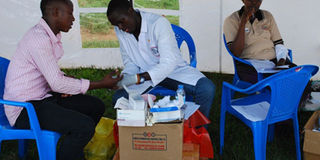How Masaka hospital is making gains in HIV test-and-treat policy

Testing. A health worker (centre) draws blood from a client at a mobile health camp in Masaka District last year. PHOTO BY MARTINS E. SSEKWEYAMA
What you need to know:
- Results. The health facility now registers one or zero cases of mother-to-child transmission of the virus and has built public confidence towards positive living.
Masaka.
Masaka Regional Referral Hospital has embraced the test-and-treat policy as released by the Ministry of Health to strengthen the campaign against HIV/Aids.
In 2016, the ministry adopted the policy under the new consolidated World Health Organisation (WHO)’s HIV prevention, care, treatment and support strategy.
According to the policy guidelines, a person is immediately put on antiretroviral drugs (ARVs) as soon as they test positive.
The policy also recommends that all HIV-infected individuals are eligible for antiretroviral treatment at diagnosis, regardless of their disease stage and CD-4 cell count.
It replaced the 2013 HIV treatment guidelines that recommended only infected persons with advanced-opportunistic secondary infections of tuberculosis and with low CD-4 cell count (below 350) for ARV drugs.
The guidelines for the policy are aligned with the global 90-90-90 targets, whereby WHO and Unaids recommended that by 2030, 90 per cent of all people know their HIV status, 90 per cent of all HIV-infected individuals are on antiretroviral therapy, and 90 per cent of those on antiretroviral therapy have achieved viral load suppression.
Early treatment
Dr Nathan Onyachi, the Masaka hospital superintendent, says they have registered fewer cases of people living with HIV showing up with an already depleted immune system as a result of implementing the policy guidelines.
Dr Onyachi says the hospital created more testing points at different departments to increase the provision of HIV/Aids healthcare services.
“A person can reliably get HIV/Aids-related services from testing onwards from almost all entry points of this hospital,” he says.
Dr Sulait Kawooya, the officer in-charge of Aids Health Foundation facility at the hospital, says the policy has also reduced mother-to-child transmission of the virus.
“Previously, we used to get five to nine babies born of HIV exposed mothers acquiring the virus during delivery on a monthly basis, but when we started this vigilance, we are now registering one or zero HIV infections from positive mothers,” Dr Kawooya says.
He says the policy has also built public confidence towards positive living, adding that several illusions that previously frustrated prevention efforts are now being attended to.
According to Dr Kawooya, the policy has also been adopted by lower health facilities thus reducing the HIV/Aids prevalence.
“The concept in the policy is that the patients’ viral-load is highly suppressed with drugs, thereby reducing chances of transmitting the virus, which gives hope that it may lead to reduction in general HIV prevalence in the long-run,” he says.
The facility has a total of 14,000 clients enrolled on ARVs, and operates 27 other branches that offer similar services around the sub-region.
Dr Kawoya says although the policy has created a shortage of ARVs supplies in some facilities, there has been consistency in delivery of the associated services hence rising public trust and awareness.
He also says there has been increased patients’ adherence to drugs and their willingness to return for follow-ups.
However, Dr Stephen Watiti, an expert in HIV care and treatment, currently working with Mildmay Uganda, advises clients to develop a saving culture such that they are not highly affected by unpredicted shortages in drug supplies and stock-outs.
“We are currently at advantage that we can access the drugs on the open market. It is high time we refocused the approach and encourage our people to save and have some money on them for such emergencies,” he says.
Dr Waititi also attributes the success so far registered to the recent modification in HIV drugs to invention of a single-tablet ARV dosage, which has simplified swallowing compared to the previous times where a patient could be scared by taking many sizable tablets.
Mr Aloysius Ngombya, one of the HIV patient experts at the foundation facility, attributes the progress to simplified HIV/Aids testing processes.
“Now days testing takes less than 10 minutes. This is an advantage to many men who tend to have less time for health services,” Mr Ngombya says.
Misconceptions
He, however, observes that there is a wrong perception among men to take ARVs because they think it weakens their strength.
Ms Olivia Nakanwagi, the district HIV/Aids focal person, attributes the registered success to the existence of a multiplicity of HIV related healthcare service providers, which leads to a general increase of the services coverage.
Recently, the district medical officer, Dr Stuart Musisi, said stigma is no longer a problem among people who test positive in Masaka because they can freely associate with others without being identified.
Dr Musisi said majority of the people testing positive are women because they respond quickly to treatment unlike their male counterparts who wait until the time when they become ill and think about knowing their sero status.




